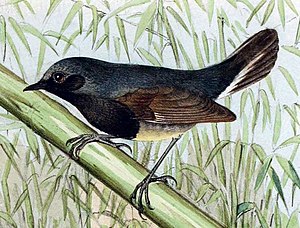Black-throated Nightingale
| Black-throated Nightingale | ||||||||||||
|---|---|---|---|---|---|---|---|---|---|---|---|---|

Black-throated nightingale ( Calliope obscura ) |
||||||||||||
| Systematics | ||||||||||||
|
||||||||||||
| Scientific name | ||||||||||||
| Calliope obscura | ||||||||||||
| ( Berezovsky & Bianchi , 1891) |
The black-throated nightingale ( Calliope obscura , Syn .: Luscinia obscura ) is a species of bird from the genus Calliope within the flycatcher family . It occurs in central China.
features
The black-throated nightingale reaches a size of 12.5 to 14.5 centimeters. In the adult male, the upper side is dark slate gray. The upper tail-coverts are dull black. The flight feathers are matt black with narrow dark gray outer hems. The wrist wings have a dirty white edge at the base. The middle pair of control springs is black. The adjoining tail feathers are white on the basal two-thirds and black on the tip third. The reins, neck, face, skull, chin, throat and goiter are deep black. The flanks are ash gray. The chest and belly are white with a creamy yellow tinge. The under tail-coverts are washed out gray. The under wing-coverts are gray with white tips. The axillary feathers are dark gray. The inside of the under wing coverts sometimes has a pale ocher-colored border. The iris is dark slate in color. The beak is black, the feet light slate gray. In the adult female, the underside has a scale pattern. The under tail-coverts are white, the tail is more tan and the legs are lighter pink.
habitat
The habitat of the black-throated nightingale has so far been little explored, but the scarce evidence suggests that it is adapted to certain habitats. In Gansu she was observed in the bamboo thicket at altitudes between 3,050 and 3,350 meters. Further evidence comes from the temperate coniferous zone in Shaanxi and Sichuan .
Way of life
Little is known about the way of life of the black-throated nightingale. In August 1886, four young birds that had fallen from the nest were found. A female collected in Thailand in February 1965 had active ovaries.
Existence and endangerment
So far there have been few records of this species during the breeding season. In 1886 four young males were collected in Gansu. One male each was observed in 1984, 1985 and 1991 in Sichuan and one female was collected in 1931. In Yunnan , a pair was observed in the secondary bushland in May 1997 and a female was collected in May 1921. Four males were collected in Shaanxi between late May and July 1905. From Thailand, where the species is a winter visitor, there are two confirmed documents and one unsecured observation. A female was collected in Chiang Rai Province in 1965. In March 2000, a couple was seen by a stream in Mae Jarim National Park . In December 1981 there is said to have been an unconfirmed sighting at Doi Inthanon .
BirdLife International leading the blackthroat in the category "endangered" ( vulnerable ), and estimates the population size of 2,500 to 10,000 individuals. The main threat is the loss and fragmentation of forests. Since the late 1960s, the forest cover in Sichuan has declined enormously due to the steadily increasing consumption of timber and the clearing of agricultural land and pasture land. Nong Bong Khai , formerly one of the most important wintering areas in Thailand, was completely destroyed by deforestation .
literature
- Josep del Hoyo et al .: Handbook of the Birds of the World. (HBW), Volume 10: Cuckoo-shrikes to thrushes. Lynx Edicions, Barcelona 2005, ISBN 84-87334-72-5 .
- Ernst Hartert: The birds of the Palearctic fauna. Systematic overview of the birds occurring in Europe, North Asia and the Mediterranean region. Volume 1, published by R. Friedländer and Son, Berlin 1910.
- Wei Qian, He Yi: First images in the wild of Blackthroat Luscinia obscura, Asia's most enigmatic Robin. In: BirdingASIA. 15, 2011, pp. 17–19 PDF, online ( memento of October 17, 2011 in the Internet Archive ).
Web links
- BirdLife International: Species Factsheet - Calliope obscura
- Threatened Birds of Asia - Luscinia obscura (PDF file, 379 kB)
- Calliope obscura inthe IUCN Red List of Threatened Species 2018.1. Listed by: BirdLife International, 2017. Retrieved October 21, 2018.